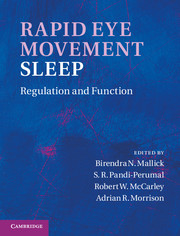Book contents
- Frontmatter
- Contents
- Contributors
- Preface
- Acknowledgments
- Organization
- Section I Historical context
- Section II General biology
- Section III Neuronal regulation
- Section IV Neuroanatomy and neurochemistry
- Section V Functional significance
- 30 Significance of deprivation studies
- 31 Modulation of body core temperature in NREM sleep and REM sleep
- 32 Sleep-related hippocampal activation: implications for spatial memory consolidation
- 33 The role of REM sleep in memory consolidation, enhancement, and integration
- 34 The role of REM sleep in emotional brain processing
- 35 REM-sleep loss, oxidative damage, and apoptosis
- 36 The role of REM sleep in maintaining neuronal excitability and its possible mechanism of action
- 37 Comparison of REM sleep-deprivation methods: role of stress and validity of use
- 38 REM sleep in patients with depression
- 39 Proteins and neuropeptides in REM-sleep regulation and function
- Section VI Disturbance in the REM sleep-generating mechanism
- Index
- Plate section
- References
31 - Modulation of body core temperature in NREM sleep and REM sleep
from Section V - Functional significance
Published online by Cambridge University Press: 07 September 2011
- Frontmatter
- Contents
- Contributors
- Preface
- Acknowledgments
- Organization
- Section I Historical context
- Section II General biology
- Section III Neuronal regulation
- Section IV Neuroanatomy and neurochemistry
- Section V Functional significance
- 30 Significance of deprivation studies
- 31 Modulation of body core temperature in NREM sleep and REM sleep
- 32 Sleep-related hippocampal activation: implications for spatial memory consolidation
- 33 The role of REM sleep in memory consolidation, enhancement, and integration
- 34 The role of REM sleep in emotional brain processing
- 35 REM-sleep loss, oxidative damage, and apoptosis
- 36 The role of REM sleep in maintaining neuronal excitability and its possible mechanism of action
- 37 Comparison of REM sleep-deprivation methods: role of stress and validity of use
- 38 REM sleep in patients with depression
- 39 Proteins and neuropeptides in REM-sleep regulation and function
- Section VI Disturbance in the REM sleep-generating mechanism
- Index
- Plate section
- References
Summary
Summary
The first and most important active defense of homeothermy in non-rapid eye movement (NREM) sleep is both reactive, i.e., depending on actual ambient temperature, and predictive, in that it is set before sleep by behavioral temperature regulation. This behavior provides thermal conditions counteracting the static influence of ambient temperature on the thermal balance of the body. An important passive defense is the thermal inertia of the body, particularly with regard to negative thermal loads. Such inertia is sufficient to buffer temporarily transient thermal imbalances due to sleep processes. In addition, under the influence of thermal loads and in the presence of an important pressure for sleep, autonomic temperature regulation is fully operative during NREM sleep without eliciting immediate awakening from sleep. This defense is energetically expensive, but the advantage is that as a result of the maintenance of brain thermal homeostasis REM sleep onset may also be promoted and then sustained for a while by the thermal inertia of the body. The important tenet is that the more the behavioral temperature regulation and the thermal inertia of the body constrain the activation of autonomic temperature regulation, the more they protect sleep from terminating. Awakening is the extreme defense of body core homeothermy but at the expense of REM sleep initially and, secondarily, of NREM sleep.
More than 40 years have elapsed since it was experimentally shown in cats exposed to cold and warm ambient thermal loads that shivering and panting, respectively, are present in NREM sleep and absent during REM sleep (Parmeggiani and Rabini, 1967). Then, the interaction between sleep and temperature regulation was the object of study in several mammals, and particularly in cats, rabbits, rats, and humans, which will be dealt with in this chapter. Such experiments not only confirmed the original result but also extended and deepened our knowledge of the changes in temperature regulation that characterize the sleep states. Nevertheless, the physiologic reason why temperature regulation is suspended during REM sleep is still a mystery.
- Type
- Chapter
- Information
- Rapid Eye Movement SleepRegulation and Function, pp. 311 - 318Publisher: Cambridge University PressPrint publication year: 2011



